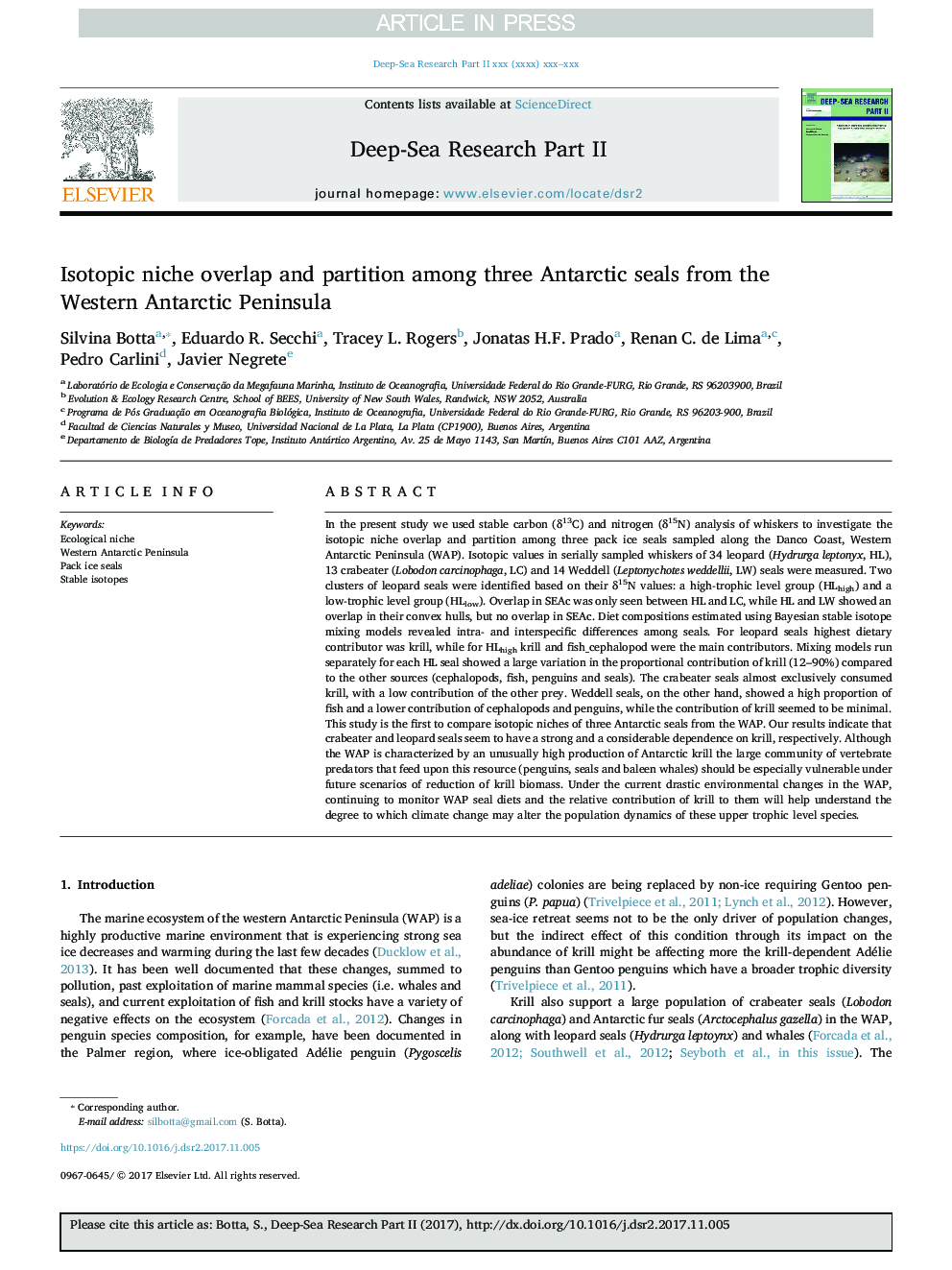| کد مقاله | کد نشریه | سال انتشار | مقاله انگلیسی | نسخه تمام متن |
|---|---|---|---|---|
| 8884438 | 1626393 | 2018 | 10 صفحه PDF | دانلود رایگان |
عنوان انگلیسی مقاله ISI
Isotopic niche overlap and partition among three Antarctic seals from the Western Antarctic Peninsula
ترجمه فارسی عنوان
مخلوط ایزوتوپها و پراکندگی در میان سه قطعه قطب جنوب از شبه جزیره قطب جنوب
دانلود مقاله + سفارش ترجمه
دانلود مقاله ISI انگلیسی
رایگان برای ایرانیان
کلمات کلیدی
طاقچه اکولوژیکی، شبه جزیره قطب جنوب غربی، مهر و موم بسته بندی یخ، ایزوتوپهای پایدار،
موضوعات مرتبط
مهندسی و علوم پایه
علوم زمین و سیارات
زمین شناسی
چکیده انگلیسی
In the present study we used stable carbon (δ13C) and nitrogen (δ15N) analysis of whiskers to investigate the isotopic niche overlap and partition among three pack ice seals sampled along the Danco Coast, Western Antarctic Peninsula (WAP). Isotopic values in serially sampled whiskers of 34 leopard (Hydrurga leptonyx, HL), 13 crabeater (Lobodon carcinophaga, LC) and 14 Weddell (Leptonychotes weddellii, LW) seals were measured. Two clusters of leopard seals were identified based on their δ15N values: a high-trophic level group (HLhigh) and a low-trophic level group (HLlow). Overlap in SEAc was only seen between HL and LC, while HL and LW showed an overlap in their convex hulls, but no overlap in SEAc. Diet compositions estimated using Bayesian stable isotope mixing models revealed intra- and interspecific differences among seals. For leopard seals highest dietary contributor was krill, while for HLhigh krill and fish_cephalopod were the main contributors. Mixing models run separately for each HL seal showed a large variation in the proportional contribution of krill (12-90%) compared to the other sources (cephalopods, fish, penguins and seals). The crabeater seals almost exclusively consumed krill, with a low contribution of the other prey. Weddell seals, on the other hand, showed a high proportion of fish and a lower contribution of cephalopods and penguins, while the contribution of krill seemed to be minimal. This study is the first to compare isotopic niches of three Antarctic seals from the WAP. Our results indicate that crabeater and leopard seals seem to have a strong and a considerable dependence on krill, respectively. Although the WAP is characterized by an unusually high production of Antarctic krill the large community of vertebrate predators that feed upon this resource (penguins, seals and baleen whales) should be especially vulnerable under future scenarios of reduction of krill biomass. Under the current drastic environmental changes in the WAP, continuing to monitor WAP seal diets and the relative contribution of krill to them will help understand the degree to which climate change may alter the population dynamics of these upper trophic level species.
ناشر
Database: Elsevier - ScienceDirect (ساینس دایرکت)
Journal: Deep Sea Research Part II: Topical Studies in Oceanography - Volume 149, March 2018, Pages 240-249
Journal: Deep Sea Research Part II: Topical Studies in Oceanography - Volume 149, March 2018, Pages 240-249
نویسندگان
Silvina Botta, Eduardo R. Secchi, Tracey L. Rogers, Jonatas H.F. Prado, Renan C. de Lima, Pedro Carlini, Javier Negrete,
